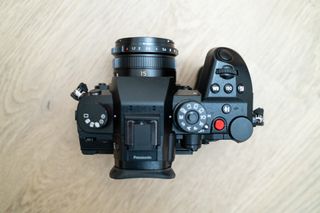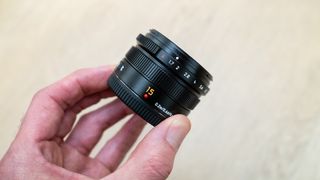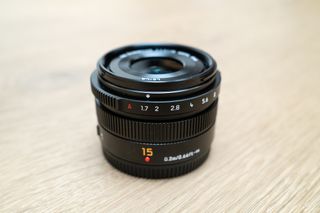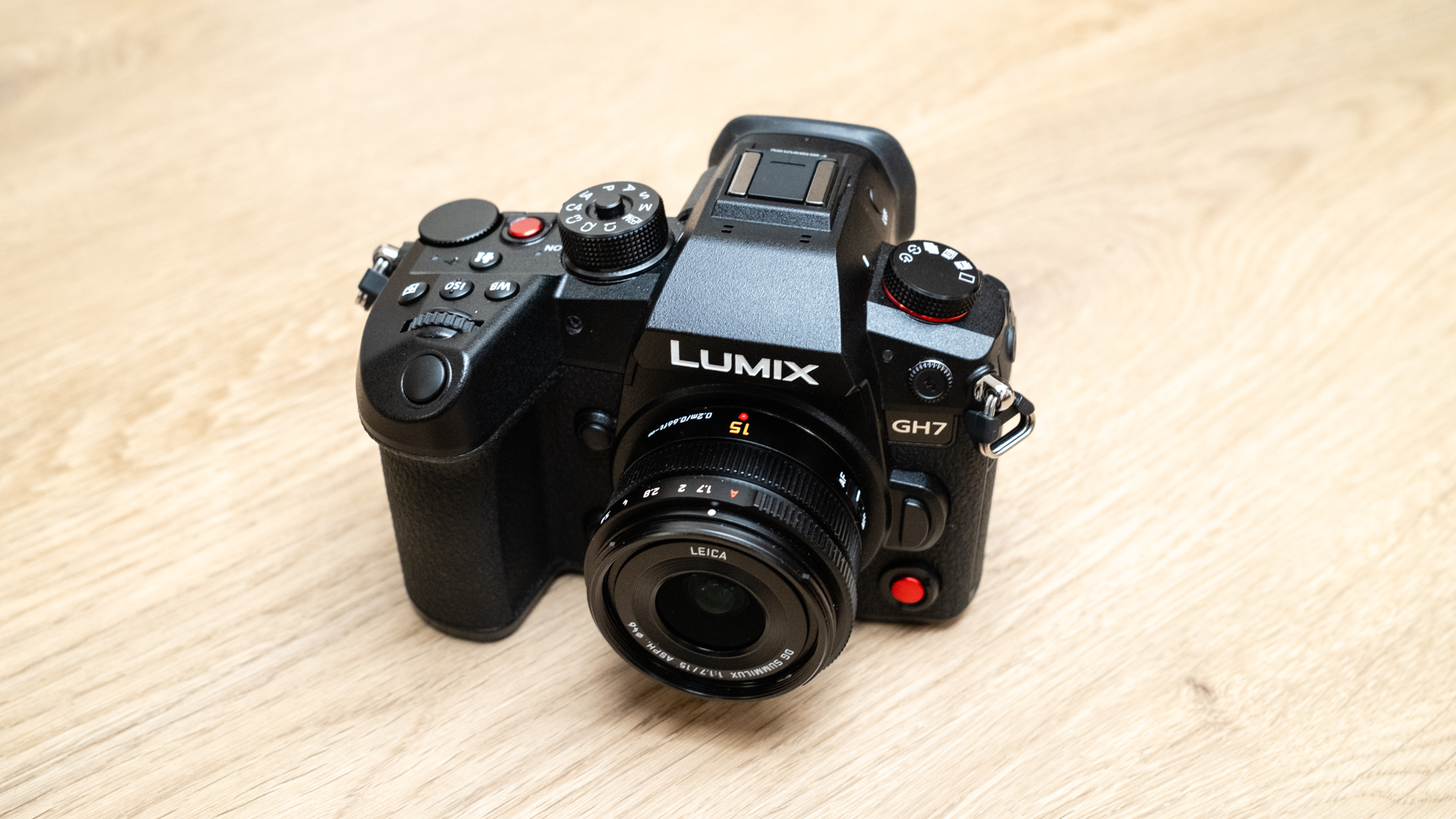Key specs
Type: Prime lens
Focal length: 15mm (30mm equivalent)
Maximum aperture: f/1.7
Lens mount: Micro Four Thirds
Weight: 4.06 oz / 115 g
Dimensions: 1.42×2.26 in / 36×57.5 mm
Filter thread: 46mm
Release date: March 2014
In the fast-paced world of photography where new kit is constantly released, you may wonder where a 10-year-old lens fits into the equation. The Panasonic Leica Summilux DG 15mm f/1.7 ASPH remains a fantastic prime lens for Micro Four Thirds (MFT) cameras thanks to its compact size, light weight, and solid overall performance. This lens provides a full-frame equivalent focal length of 30mm making it a versatile option for a range of subjects.
Thanks to its versatile focal length and fast f/1.7 maximum aperture, this lens can be used for landscape, cityscape, street photography, and of course, astrophotography. The latter, along with the former, makes it a compelling option for astrophotographers who shoot with Panasonic or OM System (Olympus) cameras. Many astrophotographers shoot with ultra-wide-angle lenses to capture as much of the night sky as possible, but sometimes you need a narrower field of view, and a prime lens that sits around the 30mm mark is often a great choice. This allows you to incorporate foreground elements such as structures and the landscape itself while still offering a wide enough field of view to include the night sky.
The Panasonic 15mm is reasonably priced at $498 / £499 considering the durable metal design and excellent build quality. It is certainly not the fastest or widest Panasonic lens available, but when attached to one of the best mirrorless cameras, it undoubtedly holds its own by providing great performance when capturing the night sky alongside other popular subjects.
Panasonic Leica Summilux DG 15mm f/1.7 ASPH: Design
- Compact and lightweight
- Manual aperture ring
- Manual / autofocus switch
What is immediately striking about this lens is how compact and lightweight it is. So much so that at just 1.42×2.26 in / 36×57.5 mm with a weight of 4.06 oz / 115 g, you will barely even notice the Panasonic 15mm is attached to your camera.
This certainly isn’t a bad thing when you’re frequently hiking to dark locations away from light pollution. Not to mention, lighter lenses mean you can carry more with you to ensure you have more options during a location shoot.
The lens features a durable metal design and is well-made despite its light weight. It is designed for photography and video, sporting a manual aperture ring, a manual focusing ring, and a manual/autofocus switch on the side. There are no bells or whistles here, just everything you need in a simple prime lens.

The Panasonic 15mm is made up of nine elements in seven groups, which include three aspherical lenses. The aperture comprises seven diaphragm blades; more diaphragm blades mean a more circular aperture which produces more circular bokeh, but for astrophotography, where you will be shooting at f/1.7, this is of no consequence.
Being such a compact lens, you may think that the Panasonic 15mm isn’t suitable for professional use, but it is perfectly capable of meeting the needs of more demanding photographers. MFT lenses, even longer telephoto primes, are significantly smaller and lighter than their full-frame counterparts, so the Panasonic 15mm’s design comes as no surprise and fits within the system well.
Panasonic Leica Summilux DG 15mm f/1.7 ASPH: Functionality
- No optical Image Stabilization
- Fast and silent autofocus
- Short minimum focusing distance
Being a fairly standard prime lens, the Panasonic 15mm isn’t packed with a range of features like some of the more expensive full-frame prime lenses. There is no Optical Image Stabilization, which is not a problem because most Panasonic Lumix cameras have in-body Image Stabilization (IBIS).
Including Optical Image Stabilization would drastically increase the size, weight, and cost of the lens, so its absence presents no issues. Furthermore, this is not a feature astrophotographers would use when shooting the night sky, so there is no real loss on several counts.
Autofocus is fast and silent, which is great for photography and video. For the latter, it is especially useful because it means that videographers can use autofocus alongside an on-camera mic without capturing the sound of the lens focusing. In reality, most videographers use manual focus, but it is still useful for those who do use autofocus.
As previously mentioned, the Panasonic 15mm features a manual aperture ring that covers all apertures from f/1.7 to f/16. There’s also an A setting that allows you to change the aperture using camera controls so you can choose the method that works best for you.
The minimum focusing distance is just 7.92 in / 20 cm, which means that you can shoot subjects fairly close up and further expand the lens’s creative possibilities.
Panasonic Leica Summilux DG 15mm f/1.7 ASPH: Performance
- Great image quality
- Vignetting wide open
- The sweet spot of the lens is f/4
Prime lenses traditionally produce superior image quality to zoom lenses, and the Panasonic 15mm fits this narrative perfectly with excellent overall image quality. What is of particular interest here is that images shot at the maximum f/1.7 aperture are perfectly sharp in the central area of the frame, which is great news for astrophotographers. There is, however, some distortion and vignetting, but this can be easily fixed in software such as Lightroom and detail remains sharp. Corner sharpness is reduced when compared to shots taken at f/4, but this is common with most large aperture primes, so it is to be expected. This lens performs best in terms of sharpness between f/2.8 and f/4.

f/4 itself appears to be the sweet spot of the lens where detail across the image is captured at its sharpest, but the center area of photos taken at f/1.7 is more than sharp enough.
This aperture also allowed the Aurora Borealis to be captured at just ISO 800 while shooting night scenes under the light of a full moon only required ISO 400. This lens was tested with the Panasonic Lumix GH7, which, in combination, provided a highly effective kit for capturing the night sky.
Panasonic Leica Summilux DG 15mm f/1.7 ASPH: Price
At just $498 / £499 the Panasonic Leica Summilux DG 15mm f/1.7 ASPH is reasonably priced within the Panasonic lens range; there are more expensive and less expensive prime lenses available, but the balance between cost, build quality, optical performance, features and usability can’t be faulted.
When purchasing the lens, you also get a lens cap, rear lens cap, lens hood, lens hood cap, and a lens storage bag. This is all pretty much standard with any lens with the most useful included accessory being the lens hood for shielding the lens from direct light that can cause flare.
Should you buy the Panasonic Leica Summilux DG 15mm f/1.7 ASPH?
If you need an MFT lens with a 30mm equivalent focal length, there is no reason not to buy the Panasonic Leica Summilux DG 15mm f/1.7 ASPH. This fast prime lens produces excellent image quality, but it’s not perfect; the main optical deficiencies are easily corrected in software such as Adobe Lightroom.
Compared to full-frame cameras, the larger depth-of-field produced by MFT cameras and lenses means that foreground elements in astrophotography shots can be perfectly sharp when shooting at maximum apertures. The advantage here is that it has the same light-gathering capabilities but with a larger depth of field.
The only time you would not want this lens is if you would prefer a prime lens with an 18mm, 24mm, or 50mm equivalent focal length, for which alternative options are available.
If this lens isn’t for you
We currently have no other Micro Four Thirds short prime lenses reviewed on Space but we will be adding more reviews to the website to deliver the best MFT lens options for astrophotography.
This certainly doesn’t mean that there aren’t some other great options available at a range of prices to suit every budget. This includes the premium Panasonic Leica Summilux DG 12mm f/1.4 ASPH with its ultra-fast maximum aperture and 24mm equivalent focal length.
More budget-oriented options include the Panasonic Leica Summilux DG 25mm f/1.4 II ASPH with a 50mm equivalent focal length and the Panasonic Leica Summilux DG 9mm f/1.7 ASPH with an impressively wide 18mm equivalent focal length.








